
Pityrodia is a genus of flowering plants in the mint family, Lamiaceae and is endemic to Australia, most species occurring in Western Australia, a few in the Northern Territory and one in Queensland. Plants in this genus are shrubs with five petals joined to form a tube-shaped flower with four stamens of unequal lengths.

Eremophila flaccida is a flowering plant in the figwort family, Scrophulariaceae and is endemic to Western Australia. It is a low, spreading shrub with sticky, shiny foliage and large, attractive flowers. There are two subspecies, one common and relatively widespread, the other known from only a few locations.

Eremophila phyllopoda is a flowering plant in the figwort family, Scrophulariaceae and is endemic to Western Australia. It is an erect or spreading shrub, sometimes round or flat-topped with sticky, hairy leaves and flowers ranging in colour from pink or lilac to purple.
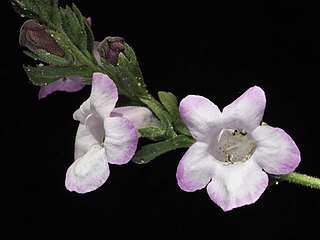
Dasymalla teckiana is a flowering plant in the mint family Lamiaceae and is endemic to Western Australia. It is a small, openly branched, sticky shrub with mauve and white, bugle-shaped flowers.

Pityrodia loricata is a flowering plant in the mint family Lamiaceae and is endemic to Australia. It is a dense, greyish, multi-stemmed shrub with whorled leaves, prominent sepals and pale, pinkish-white flowers. It is common in Western Australia and the Northern Territory and there is a single record from South Australia.

Pityrodia byrnesii is a flowering plant in the mint family Lamiaceae and is endemic to Arnhem Land in the Northern Territory. It is a shrub with hairy, glandular stems, stalkless, flat leaves and fragrant, off-white, bell-like flowers with purple stripes inside the tube.
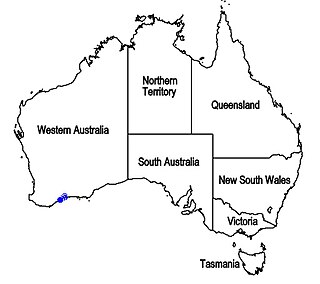
Hemiphora exserta is a flowering plant in the mint family Lamiaceae and is endemic to the south-west of Western Australia. It is a sprawling shrub with its branches densely covered with white, woolly hairs. Its leaves are rough and wrinkled and the flowers are deep pink or dark red, curved and tube-shaped with spreading petal lobes on the end.
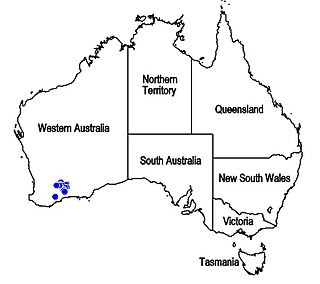
Hemiphora lanata is a flowering plant in the mint family Lamiaceae and is endemic to the south-west of Western Australia. It is a sprawling shrub with its branches and leaves densely covered with white, woolly hairs and with deep pink or dark red, curved, tube-shaped flowers with spreading petal lobes on the end. It is similar to Hemiphora exserta except for its cottony leaf-covering and its longer stamens.

Pityrodia gilruthiana is a flowering plant in the mint family Lamiaceae and is endemic to Arnhem Land in the Northern Territory. It is a dark green, spreading shrub with sticky, glandular branches and leaves and fragrant, off-white, bell-like flowers with purple stripes on the end.
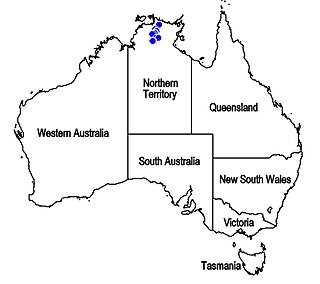
Pityrodia pungens is a flowering plant in the mint family Lamiaceae and is endemic to the northern part of the Northern Territory. It is an erect, spreading shrub with narrow, prickly leaves and off-white, bell-like flowers with dark purple streaks.

Pityrodia ternifolia is a species of flowering plant in the mint family, Lamiaceae and is endemic to north-western Australia. It is an erect shrub with densely hairy stems, sticky and prickly, egg-shaped leaves, and mauve or pinkish-red, tube-shaped flowers.
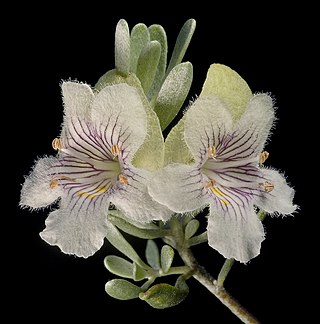
Prostanthera althoferi is a species of flowering plant in the family Lamiaceae and is endemic to inland areas of Australia. It is an erect shrub with its stems and leaves densely covered with silvery, greyish-green hairs, and has narrow egg-shaped leaves and white to cream-coloured flowers with mauve or purple striations inside.

Prostanthera baxteri is a species of flowering plant in the family Lamiaceae and is endemic to the south-east of Western Australia. It is an erect shrub with narrow egg-shaped to linear leaves and white flowers with a tinge of blue to pale mauve.

Prostanthera semiteres is a species of flowering plant in the family Lamiaceae and is endemic to Western Australia. It is a small shrub with narrow egg-shaped leaves with the narrower end towards the base and pink or red flowers.

Prostanthera verticillaris is a species of flowering plant in the family Lamiaceae and is endemic to a restricted area of Western Australia. It is a spreading shrub with whorled, egg-shaped to elliptic leaves and white to purplish-blue flowers.
Hibbertia scabra is a species of flowering plant in the family Dilleniaceae and is endemic to the north of the Northern Territory. It is a small shrub with hairy foliage, linear to narrow elliptical leaves and yellow flowers arranged singly near the ends of branches with about fifty stamens arranged around two densely scaly carpels.
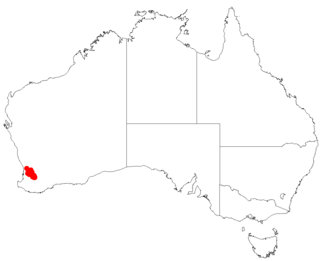
Leucopogon darlingensis is a species of flowering plant in the heath family Ericaceae and is endemic to the south-west of Western Australia. It is an erect shrub with hairy young branchlets, spirally arranged, linear, oblong, narrowly elliptic or narrowly egg-shaped leaves and white, bell-shaped flowers arranged in upper leaf axils and at the ends of branches.
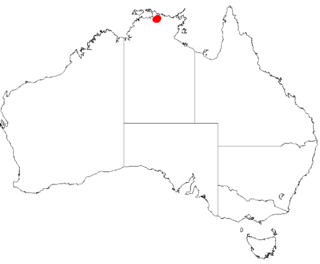
Pityrodia serrata is a species of flowering plant in the mint family Lamiaceae and is endemic to the northern part of the Northern Territory. It is an erect shrub with sharply-pointed, egg-shaped leaves with serrated edges, and off-white, bell-shaped flowers streaked with purple.

Pityrodia spenceri is a species of flowering plant in the mint family Lamiaceae and is endemic to the northern part of the Northern Territory. It is an erect shrub with hairy, heart-shaped or egg-shaped leaves, and white, tube-shaped flowers.
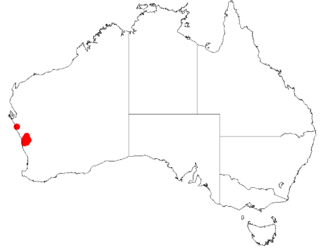
Pityrodia viscida is a flowering plant in the mint family Lamiaceae and is endemic to the south-west of Western Australia. It is an erect shrub with sticky hairy stems, egg-shaped to narrowly elliptic leaves and white bell-like flowers.





















